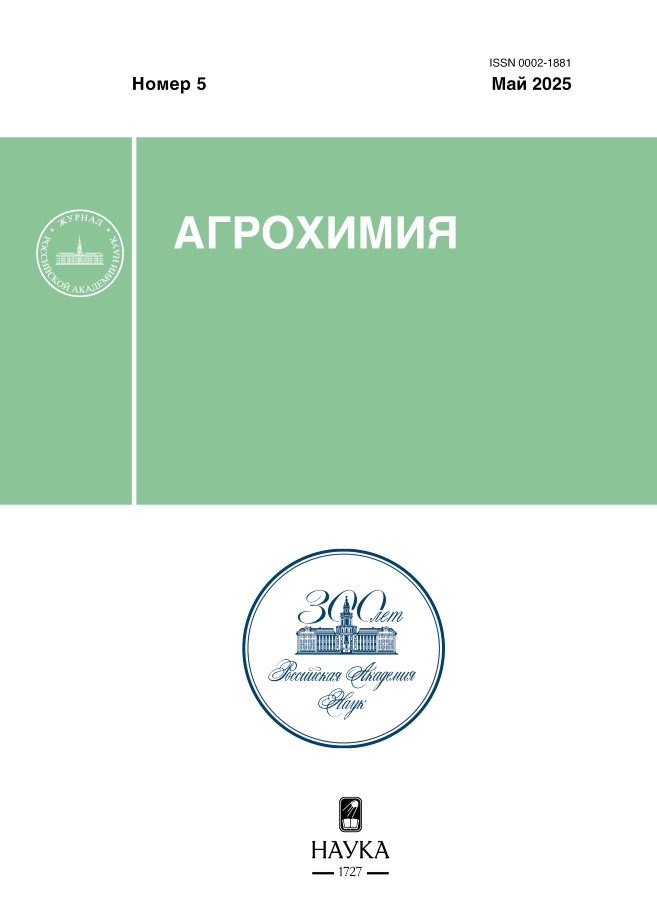Effect of prolonged use of certain elements of agrotechnology on the fertility of gray forest soil in the subtaiga zone of the Omsk Irtysh region
- Авторлар: Balabanova N.F.1, Voronkova N.A.1, Khramov S.Y.1
-
Мекемелер:
- Omsk Agrarian Scientific Center
- Шығарылым: № 5 (2025)
- Беттер: 27-34
- Бөлім: Soil Fertility
- URL: https://freezetech.ru/0002-1881/article/view/685254
- DOI: https://doi.org/10.31857/S0002188125050036
- EDN: https://elibrary.ru/TVQVWE
- ID: 685254
Дәйексөз келтіру
Аннотация
In a stationary experiment, the fertility of gray forest soil was assessed depending on the type of crop rotation and the use of mineral fertilizers. The object of the study is gray forest soil. The scheme of the experience is two-factor (2 × 2). Factor A – 4-full grain-steam crop rotations 1 and 2, characterized by different saturation of grain crops and the type of steam. Factor B – mineral fertilizers, options: 1 – without fertilizers (Y0), 2 – N30P45K45 (Y1). The observation period was 20 years (2003–2022). It was revealed that the replacement of pure steam with occupied steam, the introduction of leguminous crops (peas) stabilized the humus content in the soil due to a greater intake of mortmass, with high e.e. nitrogen enrichment (C : N = 9.9). The systematic use of phosphorus-containing fertilizers in crop rotations at a dose of P45 ensured a positive balance of this element in the soil. It was found that in the conditions of the subtaiga zone, due to the scientifically based selection of crops in crop rotation, their productivity increased by 0.21 t/ha and by 0.30 t/ha with the use of fertilizers (N30P45K45).
Негізгі сөздер
Толық мәтін
Авторлар туралы
N. Balabanova
Omsk Agrarian Scientific Center
Хат алмасуға жауапты Автор.
Email: natascha.balabanowa@mail.ru
Ресей, Korolev av. 26, Omsk 644012
N. Voronkova
Omsk Agrarian Scientific Center
Email: natascha.balabanowa@mail.ru
Ресей, Korolev av. 26, Omsk 644012
S. Khramov
Omsk Agrarian Scientific Center
Email: natascha.balabanowa@mail.ru
Ресей, Korolev av. 26, Omsk 644012
Әдебиет тізімі
- Вальков В.Ф. Казеев К.Ш., Колесников С. И. Почвоведение: учебник. 4-е изд., перераб. и доп. М.: Юрайт, 2018. 527 с.
- Ганжара Н.Ф. Борисов Б.А. Почвоведение: учебник. М.: РГАУ–МСХА им. К.А. Тимирязева, 2019. 257 с.
- Алябина И.О. Картографическая оценка разнообразия почв России // Вестн. МГУ. Сер. 17: Почвоведение. 2018. № 1. С. 8–15.
- Петуховский С.Л., Рейнгард Я.Р. Влияние природных и антропогенных факторов на урожайность зерновых культур в Омской области // Омск. научн. вестн. 2012. № 1(108). С. 167–170.
- Илюшкина О.В. Баланс органического вещества в нечерноземной зоне Омской области // Мичурин. агроном. вестн. 2022. № 3. С. 84–89.
- Гулюк Г.Г. Обзор состояния и необходимых мер в подготовке концепции развития АПК нечерноземной зоны // Мелиорац. и водн. хоз-во. 2020. № 5. С. 2–4.
- Система адаптивного земледелия Омской области. Омск: ИП Макшеевой Е.А., 2020. 522 с.
- Горшенин К.П. Почвы южной части Сибири (от Урала до Байкала). М.: Изд-во АН СССР, 1955. 591 с.
- Мищенко Л.Н. Мельников А.Л., Аксенова Ю.В. Почвы Западной Сибири: учеб. пособ. Омск: Омск. ГАУ им. П.А. Столыпина, 2018. 284 с.
- Ториков В.Е., Мельникова О.В., Сидорова Е.Ю., Мельников Д.М. Изменение плодородия серой лесной почвы в плодосменном севообороте // Агрохим. вестн. 2019. № 2. С. 6–9.
- Гладышева О.В., Свирина В.А., Артюхова О.А. Влияние севооборотов и минеральных удобрений на гумусное состояние почвы в длительном стационарном опыте // Аграрн. наука. 2020. № 10. С. 83–87.
- Семешкина П.С., Бородина Е.С. Влияние бобовых культур и удобрений на продуктивность севооборотов и плодородие почвы // Аграрн. вестн. Урала. 2023. Т. 23. № 12. С. 12‒21.
- Дмитриев Н.Н. Гамзиков Г.П. Систематическое применение удобрений как фактор стабилизации плодородия серых лесных почв и продуктивности зерновых культур в зернопаровом севообороте // Агрохимия. 2015. № 2. С. 3–12.
- Окорков В.В. Влияние удобрений на агрохимические свойства и продуктивность севооборотов на серых лесных почвах Верхневолжья // Изв. Оренбург. ГАУ. 2019. № 6(80). С. 18–22.
- Лапа В.В., Серая Т.М., Богатырева Е.Н., Бирюкова О.М. Влияние длительного применения удобрений на групповой и фракционный состав гумуса дерново-подзолистой легкосуглинистой почвы // Почвоведение. 2011. № 1. С. 111–116.
- Еремин Д. И. Груздева Н. А., Еремина Д. В. Изменение гумусового состояния серых лесных почв восточной окраины Зауральского плато под действием длительной распашки // Почвоведение. 2018. № 7. С. 826–835.
- Мансапова А.И., Котелкина Л.Л., Банкрутенко А.В. Формирование полевых севооборотов в условиях подтаежной зоны Западной Сибири: метод. пособ. Омск: Вариант–Омск, 2014. 20 с.
- Никитин Б.А. Метод определения гумуса почвы // Агрохимия. 1999. № 5. С. 91–93.
- Шарков И.Н., Самохвалова Л.М., Шепелев А.Г. Изучение изменений содержания лабильного органического вещества в почве при использовании ее в различных севооборотах // Проблемы рационального использования малоплодородных земель: мат-лы Международ. научн.-практ. конф. (г. Омск, 28–29 апреля 2009 г. РАСХН, СО; СибНИИСХ. Омск, 2009. С. 98–102.
- Доспехов Б.А. Методика полевого опыта с основами статистической обработки результатов исследований. М.: Альянс, 1985. 352 с.
- Коржов С.И., Солодовников, К.И., Пимонов М.А., Несмеянова А.П. Влияние бобовых культур на плодородие почвы и продуктивность севооборотов // Агрохим. вестн. 2022. № 3. С. 54–59.
- Бойко В.С., Воронкова Н.А., Тимохин А.Ю., Балабанова Н.Ф. Вклад многолетних кормовых культур в азотный баланс агроэкосистем Западной Сибири // Аграрн. наука Евро-Северо-Востока. 2023. Т. 24. № 2. С. 249–256.
- Балабанова Н.Ф., Воронкова Н.А., Дороненко В.Д. Содержание лабильного органического вещества в лугово-черноземной почве при длительном применении удобрений // Земледелие. 2020. № 2. С. 7–9.
- Лисина А.Ю., Власов В.Р. Влияние сидерации на повышение урожайности зерновых культур // Совершенствование технологий производства и повышения качества продукции растениеводства: сб. научн. тр. Н. Новгород: НГСХА, 2008. С. 93–94.
- Пигорев И.Я., Беседин Н.В., Ишков И.В., Грудинкина В.В. Поддержание и сохранение почвенного плодородия в условиях органического земледелия // Вестн. Курск. ГСХА. 2018. № 9. С. 7–14.
- Гамзиков Г.П. Агрохимия азота в агроценозах. Новосибирск: Изд-во ИИЦ ГНУ СибНСХБ РАСХН, 2013. 790 с.
Қосымша файлдар













